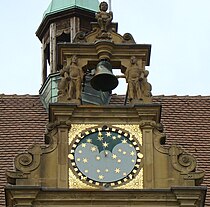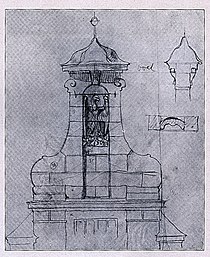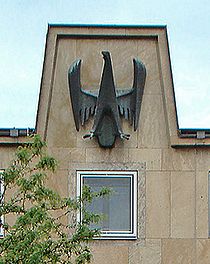Art clock (Heilbronn)
The Heilbronn art clock is located on the old, historical part of the town hall in Heilbronn . It is an astronomical clock from the 16th century with three dials and chimes and chimes. The lower dial is located in the facade, which is continued upwards with a diaphragm to accommodate the other parts . The clockwork that was destroyed in the Second World War was reconstructed and the damaged front was restored.
description
history
The Heilbronn art clock was made by Isaac Habrecht in 1579 and 1580 , using parts of an older art clock by Hans Paulus from 1525. The painting and gilding was done by Hans Peter Eberlin . In 1896 the historical clockwork was replaced by a new one from the company Hörz from Ulm. When Heilbronn was destroyed by bombs in 1944, the town hall and its clock were also affected. The Hörz company built another clockwork in 1953, which is still in service today. For the reconstruction of the town hall, the flasher and plumber Wilhelm Klagholz made the two rams, the rooster and the city eagle as a forged sculpture made of copper. On September 4, 1953, the restoration of the clock was completed under the artistic direction of Ingeborg Wolf .
The displays on the three dials
The art clock is in three parts:
- Above: moon clock ,
- Middle: 12-hour clock ,
- Below: zodiac clock .
- Ads and figures
Moon clock
The moon clock is located on the double gable of the dwelling, which is decorated with volutes . The upper part of the gable carries the council bell. Two male figures strike the bell every quarter of an hour. A putti sits enthroned at the top . The clock itself is located in the lower part of the gable and symbolically shows the phases of the moon on a disc protruding from under the dial. A centric pointer indicates the age of the moon in 1 to 30 days on the outer scale.
12 hour clock
The 12-hour clock ( small clock ) has an hour and a minute hand. Between the two corresponding scales there is a third scale on which only the quarter hours are marked.
Two angels (one each to the left and right of the clock) turn just before the hour strikes. The angel on the right blows a trumpet, the one on the left turns an hourglass and counts the strikes of the bells by moving his scepter. Two gold-plated rams stand opposite each other under the hour circle. They straighten up a little with every strike of the hour and bump their heads together. In a niche under the rams is a rooster that crows and unfolds its wings at the fourth, eighth and twelfth hours.
Zodiac clock
The zodiac clock shows mainly astrological facts and is the main part of the Heilbronn art clock.
The clockwise zodiac forms the main scale, which is also surrounded by a scale with the names of the months. The mark every 5th day of the month is numbered. On this scale, a sun and a moon hand show the position of the sun and moon in the zodiac images. The sun hand needs 365 days, the moon hand 27 1/3 days for one revolution.
The day of the week is displayed in the middle with a third hand. The days of the week are marked with the regents of the day Sun, Moon, Mars, Mercury, Jupiter, Venus and Saturn.
Notice boards
Below the clock gable is a plaque with the following verses:
|
In the beginning God in the highest throne |
The middle course to night and days, |
The clock of angels Schnell Mmbwendt |
reception
Gottfriedle and Jaköble
A legend tells of the two angels of the art clock in Heilbronn that the two, in the form of young girls, wander between the half-timbered houses through the alleys and streets of the former Heilbronn old town and “admonish peaceful coexistence” : “If you look them in the eye, you forget anger , Anger and stress, joy fills him, he wants to hug the whole world ” .
- The one angel "Gottfriedle" , who walks through the alleys of the old half-timbered town, turns the hourglass and swings a scepter . The hourglass as a symbol of impermanence means that the time to die has come. The scepter as a symbol of power and justice means here that the judge will now be judged - Mene mene tekel ufarsin - "The clock of the angels Schnell Mmbwendt ... Means your hour In the end. ... Then with the bright G'schrei der Han ... Ermant dich, that you Buoss Soll Than "
- The other angel, the "Jaköble" , who accompanies the other angel, blows the trumpet and calls to the Last Judgment - "Des Engels Gross Pusaunen Thon ... That there will soon be God's Son ... The B'ruffen dignifies to marry ... The An Believe him at this time. "
At the parades in the city of Heilbronn, in the post-war period, young girls play the roles of "Gottfriedle" and "Jaköble" . For the pageant in 1955, the set designer Herbert Buhe made the props such as scepter, hourglass and trombone. His daughter Ingeborg takes on the role of "Jaköble" . Ingeborg Buhe later marries the Hessian long-day delegate Armin Clauss from Lauffen am Neckar . Her friend Ingrid Bressmer (Staudacher) from Sontheim plays the "Gottfriedle" .
Clock gable
The clock gable on the old, historical part of today's Heilbronn town hall was discussed several times architecturally in later times. For the first time when the old theater was built . There were differences of opinion regarding the construction of the upper end of the main facade. After the colleges had discussed on February 23, 1912 whether the new theater building should have a gable with the Heilbronn city eagle or a turret with a clock, they voted on March 8, 1912 in favor of the Heilbronn city eagle in the middle of a gable field that reproduced the old forms of the clock gable . In the post-war period, a gable field was built on the south wing of the new extension of the town hall, which represents a reception of the gable of the art clock - it is a "gable field above the entrance on the market square ... which ... architecturally ... represents a certain repetition of the clock gable on the historic town hall ], but in a modest and different way, explains the master builder [Rudolf Gabel]. "
- Reception of the clock gable
swell
Web links
- The art clock in the Heilbronn city archive
- Heilbronn city archive
- Stadtarchiv Heilbronn, contemporary history collection, signature ZS-1923, entry on Théodore Ungerer: Les Habrecht: Une dynastie d'horlogers strasbourgeois au XVIe et au XVIIe siècle + Willi Zimmermann: Old town hall clock and its builder, clockmaker Isaak Habrecht of Strasbourg , Heilbronn 1953. in the Database HEUSS
Individual evidence
- ^ The Heilbronn town hall. Accessed December 30, 2019 .
- ↑ a b Helmut Schmolz, Hubert Weckbach: Heilbronn. History and life of a city . 2nd Edition. Konrad, Weißenhorn 1973, ISBN 3-87437-062-3 , No. 300 The art clock at the town hall , page 104
- ↑ Every day his rooster crows from the town hall . In: Heilbronner Voice of April 2, 2002
- ↑ Uwe Jacobi: That was the 20th century in Heilbronn . Wartberg-Verlag, Gudensberg-Gleichen 2001, ISBN 3-86134-703-2 , p. 57: 1953, September 4th: Art clock shines again
- ↑ Uwe Jacobi: Heilbronn as it was . Droste, Düsseldorf 1987, ISBN 3-7700-0746-8 , page 26
- ^ Association for Tourism Heilbronn [Tourist Office] (ed.): Guide through the town hall and Kilian's Church in Heilbronn , Schell'sche Buchdruckerei, Victor Kraemer Heilbronn, 1907–1910 [Heilbronn city archive, Heuss database, archive signature L006-Hc 2 Fue-1910 ], P. 8.
- ↑ a b c d Uwe Jacobi: A generation's attitude to life: The 50s in Heilbronn and the region. Volume II. Wartberg Verlag. 1st edition 2002. ISBN 3-8313-1035-1 : Gottfriedle page 14
- ↑ Rudi Fritz: In the heart of Heilbronn . In: Special supplement of the Heilbronner Voice on the occasion of the completion of the extension building . Heilbronn February 10, 1962.







